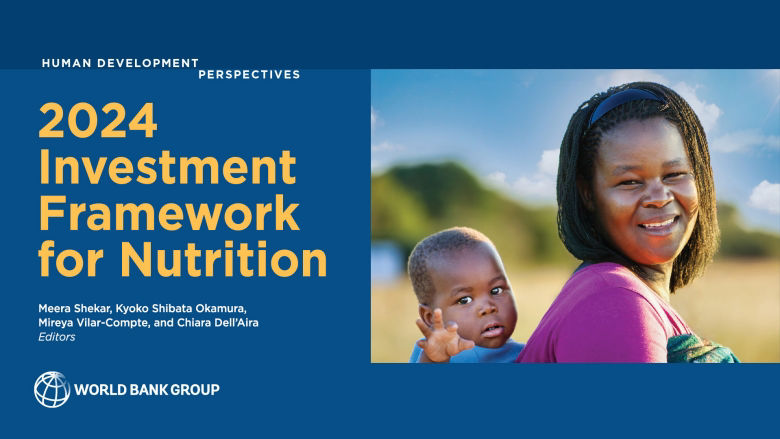Malnutrition is one of the world’s most serious but least-addressed development challenges. Its human and economic costs are enormous, falling hardest on the poor, women, and children.
In 2024, over 150 million children under five years old were stunted (low height-for-age), which indicates not only a failure to achieve one’s own genetic potential for height but is also a predictor of many other developmental constraints, including cognitive deficits and future economic opportunities, including impeding a country’s ability to accumulate human capital.
Over the last three decades, the worldwide prevalence of stunting declined from 40 percent in 1990, to 23.2 percent in 2024. However, global rates have plateaued over the past several years, and we are drifting further away from the trajectory needed to halve the stunting rates by 2030, according to the Joint Child Malnutrition Estimates (JME).
Recent food price hikes exacerbate the situation, further compounded by climate impacts hitting the most vulnerable people and rolling back years of progress on child undernutrition.
Regional trends
South Asia and Sub-Saharan Africa are the hardest hit, with with roughly two-thirds of the 150.2 million stunted children residing in these two regions. Albeit several countries such as Nepal, Bangladesh, Tajikistan, Burkina Faso and Rwanda have experienced rapid declines in child stunting, the total number of stunted children increased in at least 34 countries across regions.
In Africa, the number increased by over 2 million between 2012 and 2024 as a result of high fertility rates and lower rates of decline in stunting. The adverse impact of recent poly-crises on chronic malnutrition will likely further exacerbate the situation.
The economic impact
Stunting early in a child’s life can cause irreversible damage to cognitive development and has educational, income, and productivity consequences that reach far into adulthood. The economic costs of undernutrition are significant with at least $1 trillion a year because of productivity loss due to undernutrition and micronutrient deficiencies (FAO 2013).
An additional $2 trillion per year is lost due to overweight and obesity. Moreover, the global expert consortium, including the World Bank, estimated economic productivity losses equivalent to US$29 billion globally by 2023 as a result of the additional malnutrition burdens attributable to the COVID-19 pandemic. These losses are largely preventable if adequate investments in proven interventions are made, particularly those that focus on ensuring optimal nutrition in the critical 1000-day window between the start of a woman’s pregnancy and her child’s second birthday.
The burden of overweight and obesity
In parallel, rapid changes in food systems, environments, and living conditions are underway in many low- and middle-income countries (LMICs).
These changes have stimulated a rapid increase in the burden of overweight and obesity, previously considered an ailment of wealthy countries. In fact, over the past 30 years, rates of overweight have risen faster in LMICs than in high income countries, and every region has seen some increase in the prevalence in overweight children under five years.
While stunting and wasting receive the most attention, the creeping rise of overweight among children under 5 is often overlooked: a staggering 35.5 million children are now living with overweight globally--an increase of 2.4 million since 2000, widening the gap between our current trajectory and the SDG target of reducing overweight to less than 3% by 2030.
Countries are starting to experience the double burden of overweight and stunting. Today, more of the world’s overweight individuals reside in low- and middle-income countries than in high income countries. Overweight and obesity leads to increased risks of non-communicable diseases and associated medical costs, as well as to reduced productivity at work, absenteeism and disabilities, hitting poor people the hardest and increasing their vulnerability to health and economic shocks. Also see our report Unlocking the Power of Healthy Longevity.
Solutions to address undernutrition and obesity
The world must address both undernutrition and obesity simultaneously through comprehensive strategies that include scaling-up high impact interventions, fiscal policies, such as nutrition-targeted health taxes, marketing regulations, and labeling of unhealthy foods such as sugar-sweetened beverages (SSBs) and ultra-processed foods, and nutrition education for consumers. Many countries are already starting to do this (see the Global SSB Tax Database), but more is needed to foster a healthier and more sustainable future.
The 2025 UNICEF/WHO/World Bank Group Joint Child Malnutrition Estimates highlight that while wasting has slightly declined, stunting and overweight remain persistent or worsening in several regions, underscoring the urgent need for integrated, multisectoral responses.
Nutrition is also intricately linked to climate change -- Women, being the gatekeepers of household food and nutrition security, are often the first to bear the heaviest burden of climate-related adversities, surging food prices, and inflationary pressures. The most recent available estimates for anemia in women of reproductive age show that in 2024, nearly one in three women remain anemic globally.
Financing at scale is key. As domestic budgets and development assistance are constrained, leveraging innovative financing, including from the private sector are critical. As we scale up the nutrition agenda, the world needs to aim for more investment in cost-effective interventions aligned with global targets by ensuring more efficient use of available resources, using tools such as Optima Nutrition, nutrition-responsive budgeting, and nutrition public expenditure reviews.
RELATED
INFOGRAPHIC: Human Capital Index: The Story
INFOGRAPHIC: Global Nutrition Report
BLOG: Addressing Pakistan's High Level of Stunting
Global Food and Nutrition Security Dashboard
Last Updated: Jul 21, 2025


